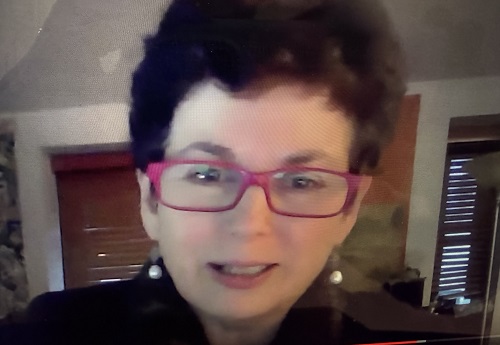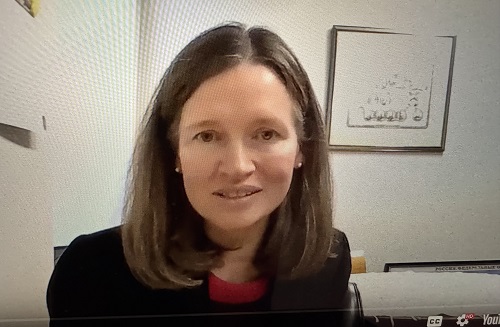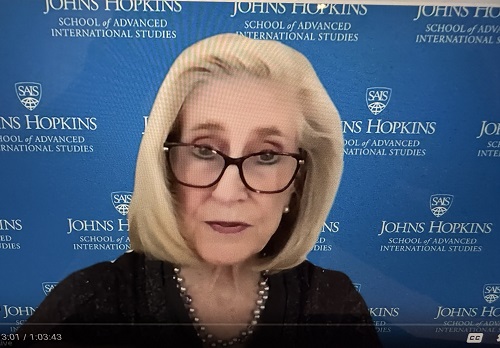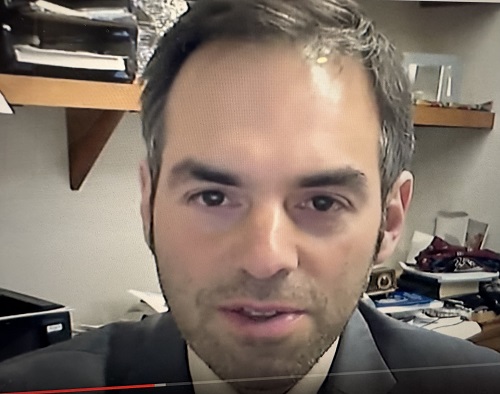Wilson Center Spotlights Shifts in Eurasian Geopolitics
By Elaine Pasquini

Washington: The Wilson Center’s Kennan Institute and South Asia Institute co-sponsored a virtual panel discussion on December 5, 2024, concerning the geopolitical shifts and new alliances in Eurasia. Kennan Institute deputy director Jennifer Wistrand moderated the one-hour program.

Elizabeth Wishnick
In terms of India and Pakistan, Michael Kugelman, director of the South Asia Institute, argued that, despite being rivals, “both are keen to engage more with the region for commercial and potential energy-related reasons. Central Asia’s gas reserves are important for both countries that depend heavily on natural gas for, among other things, transport fuel which cannot fully address demand through indigenous resources or imports from the Middle East.”
For Islamabad, Central Asia figures quite prominently in Pakistani “plans – not policies or actions – to reframe its foreign policy through what officials in Pakistan describe as geoeconomics, rather than geopolitics,” Kugelman said. “Pakistan wants its foreign policy to focus more around generating more trade and connectivity” in the Central Asian states.

Jennifer Wistrand
“The main initial focus of this envisioned Central Asia tilt for Pakistan is a potential transnational rail project involving Pakistan, Afghanistan, and Uzbekistan,” he noted. “This rail project, however, has challenges in terms of financing and security risks in Afghanistan and in terms of tensions that Pakistan has had with the Taliban since the Taliban returned to power.”
India, Kugelman said, would like to strengthen its clout in Central Asia, noting it’s a country with “major power aspirations.” It also wants to counter China and is “motivated by a desire to strengthen its outreach to the Global South.” One disadvantage India faces with its Central Asia outreach, however, is its lack of a direct land route to the region.

Marsha Olive
Central Asia would like to engage more with India and Pakistan to help in facilitating access to warm water ports in both countries for trade. Stronger commercial ties could also in principle enable the region to eventually reduce economic dependence on Russia and China, he said.
As to the reactions of Türkiye and Iran to these changing dynamics between Central and South Asia, Rohullah Osmani, a global fellow at the South Asia Institute and Kennan Institute, noted that the two countries only see Central Asia and the Caucasus as secondary foreign policy issues, although they have had active engagement in that region.

Michael Kugelman
Türkiye is focusing on leveraging its pan-Turkic connection and economic potential in the region, driven by economic opportunities, including developing infrastructure and connectivity projects, Osmani said.
Iran views itself as a natural partner to Central Asia citing a shared culture, history and heritage as well as a direct land border with Turkmenistan and Afghanistan which provide Central Asian states with their most immediate access to international waters, he said. It also seeks to expand its influence in Central Asia by positioning itself as a counterterrorism ally as Afghanistan is an area of concern for all of them.
With Western-imposed sanctions on Russia following its invasion of Ukraine prompting Central Asian countries to seek alternative trade routes, Iran emerged as a key partner in reshaping trade dynamic shifts.

Rohullah Osmani
Iran hopes to create a new economic lifeline, reduce its international isolation, and establish itself as a key position in the north-south trade route. Central Asia countries are opening up, he noted, with Uzbekistan and Kazakhstan strongly pushing for foreign investment. There are many opportunities for the new American administration in terms of private sector investments in energy and critical minerals, he added.
Elizabeth Wishnick, senior research scholar at the Weatherhead East Asian Institute at Columbia University, noted China is involved in Pakistan through its Belt and Road Initiative, a China-centric project that brings employment to China’s state-owned enterprises and helps China export its goods and find new markets.
The five Central Asian states are very diverse, and each has its own economy and different resource characteristics, Wishnick said. They are also integrated with Russia in varying degrees and Russia is determined to keep this influence and even increase it. “It becomes a very constraining neighborhood, so the countries are looking to get outside of the neighborhood to engage with multiple partners,” she pointed out.
Russia’s war on Ukraine has “scrambled the geopolitical Rubik’s cube in Eurasia,” Wilson Center global fellow Marsha McGraw Olive said. It has also “increased fear of the unpredictability of Russian foreign policy in the broader region.”
But the invasion also boosted the attractiveness of the Caucasus and Central Asia as an alternative to Russia for transit, energy, and minerals. As a result, it has stimulated competition for resources and strategic real estate across the entire Eurasian land bridge. “Countries in the Caucasus – Armenia, Azerbaijan and Georgia, and Central Asia – Kazakhstan, Kyrgyzstan, Tajikistan, Turkmenistan and Uzbekistan – are flexing their sovereign muscles in new ways,” Olive stated.
With this geopolitical change is coming a change in geoeconomics, she said. There is significant economic diversification and an increase in investment in Central Asia including from the Middle East. China has overtaken Russia as the main training partner in 2023, she noted, and Europe is significantly upping its engagement. Within the region, trade is expanding greatly and trade volumes from China to Europe across Central Asia have quadrupled, she said.
As for the United States, its main achievement in the region was the first C5+1 summit with Central Asian leaders led by President Biden. “But, otherwise, the United States, I believe, has failed to articulate a new strategy or facilitate investments to demonstrate that the region for its own sake is vital to US security,” Olive argued.
“I don’t think the United States can replace Russia or China in the economic sphere, but it can give alternatives and also facilitate institutional mechanisms among the parties,” she said in conclusion. “The new administration needs to upgrade the region as a long-term focus of US foreign policy in US national interests.”
(Elaine Pasquini is a freelance journalist. Her reports appear in the Washington Report on Middle East Affairs and Nuze.Ink.)

